How to Get the Most Out of Your Coasteering Session
If you are visiting Cornwall, coasteering should be on your 'to do' list. This guide is for anyone coasteering for the first time, or anyone who wants to hone their skills, to get the maximum enjoyment out of their coasteering session, with the least amount of effort. After all, coasteering is all about having fun!
Welcome to our ‘how to’ sharing some handy advice to make your coasteering sessions as much fun, and as little effort as possible. If you have never been coasteering before, using these pointers will make you look like an instant pro. Even if you have been coasteering before, you will probably find some information here to help you refine your techniques.
No, this guide isn’t going to tell you how to do triple backflips from 20m cliff edges like a Red Bull cliff-diving hero. But it is going to help you to coasteer efficiently, ensuring you have the most fun and that once you’re done you still have the energy to build that sandcastle, or to go and do that souvenir shopping that you’d reluctantly promised to do beforehand.
Where to go coasteering
Or more importantly, who to go coasteering with. It goes without saying that we only recommend going coasteering with a reputable company that has a proven track record of delivering quality coasteering sessions. Why is this? Firstly, every coasteering site is different and also responds to the weather, sea conditions and tides in different ways. The detailed local knowledge of all of these factors working in combination is paramount for safe coasteering, and a good coasteering guide will know every rock and every stretch of water on their patch. They will know when a jump is safe to use, when a cave is safe to enter, or whether it may be too rough. They will have issued you with the appropriate, good-quality equipment. Most importantly they should have the equipment and know-how to deal with things in the unlikely event that something should go wrong.
"It goes without saying that we only recommend going coasteering with a reputable company that has a proven track record of delivering quality coasteering sessions."
Pretty much every corner of the UK that has a suitable coastline for coasteering now has a choice of providers offering guided coasteering trips. So get on the internet and search ‘Coasteering Cornwall’, for example, or wherever you happen to be at the time. How do you sort through the pages of results? We recommend two simple steps. Firstly, check out the reviews. That will immediately give a great indication of who is the real deal when it comes to coasteering in their area.
Secondly, we strongly recommend you go coasteering only with a provider who is a member of the National Coasteering Charter, or NCC. The NCC’s stated aim is to ‘promote safe coasteering’. It is a collective of coasteering professionals whose aim is to share best practice, set standards for coasteering guides, and even learn from each other’s mistakes, when necessary. As long-time members of the NCC, we at Kernow Coasteering are very proud to be part of this pro-active organisation, and the range of experience and expertise present throughout its membership continues to impress us.
The NCC website has a handy provider search function, which means you can rapidly narrow down your search. You can even see coasteering providers on a map, making things even easier.
Starting your coasteering session
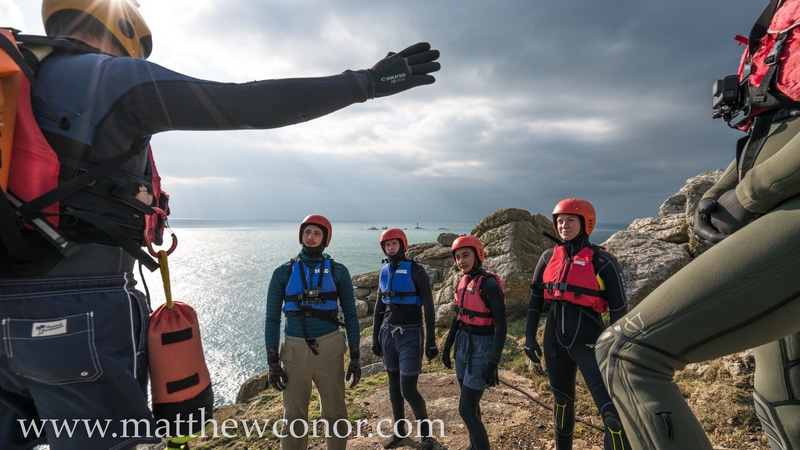
You’re at the beach, you’re changed and ready to go. You’ve been prepped with all the right gear. This will include a full-length wetsuit, a buoyancy aid, a helmet, and some suitable footwear to protect your feet. Your coasteering guide has given you a thorough safety briefing and you are psyched to go and have some fun. What follows is some micro-details that your guide will not have time to explain fully before, and maybe during the session. So as you complete the approach and get on to the route, it won’t be long before you’re…
wild swimming
Yep, that wetsuit you’ve been given isn’t just to make an impressive fashion statement. You’re going to get wet, and you will be swimming. Wild swimming refers to any swimming done in the natural environment. Wild swimming, therefore, includes swimming in rivers, lakes and, of course, the sea. Due to differences in cliff-scape across the country, and due to providers’ different approaches to coasteering, the amount of swimming you do during a coasteering session will vary. But it is reasonable to expect you may be spending up to half of your session swimming in the sea. That’s a lot of swimming if you are not used to it, and it will be a lot harder if the sea is rough.
Many of our customers are not regular swimmers. But fear not, we’re not suggesting you spend 6 months training with Michael Phelps just so you can get through a single coasteering session. Just some small changes to your technique can result in much more efficient swimming, meaning you are going to get more for less.
Don't fight the buoyancy!
The first thing you will notice is that wearing a wetsuit and a buoyancy aid, you are very buoyant. We have many people comment that this feels odd and makes swimming harder. I disagree. Use that buoyancy. It’s immediately going to put you in the optimum position for swimming through the brine like a greased electric eel. Efficient swimming requires being as straight as possible with your legs on the surface. If you are just in your swimming cossie, this can be quite difficult to achieve as your legs naturally want to sink beneath you. People looking to improve their swimming technique in the pool will spend a lot of time working on getting those heavy legs up on the surface.
So, don’t fight the buoyancy. With your legs down in the water and the body closer to a vertical position, you’re effectively being your own sea anchor, creating huge amounts of drag and making progress through the water arduous. That wetsuit and that buoyancy aid want to lift you up, so let them! With the legs held buoyantly aloft, you may find you don’t even need to kick your legs and may find you can swim effectively with arms only.
Coasteering tip: Swim in an efficient, streamlined position with a straight body and legs flat on the surface.
Coasteering Means Getting Cosy with the Rocks
If we want to be coasteering and not just wild swimming, we’re going to have to interact with the rocks. Water flowing adjacent to cliffs, rock walls, gully sides, etc., is slowed by the friction of these surfaces, whereas open water is less restricted. Why is this important? When you are swimming during your coasteering session, it’s a good idea to remain close to rock faces, providing the water is deep enough that the waves aren’t breaking against them. Here the water flow will be less; in open water, the current is stronger and is not going the way you want. Hugging the cliffs and rocks, progress will be easier.
There are added advantages to being next to the rocks. As well as swimming, you can often use holds on the rocks to assist your swimming. A good pull on a well-placed rock edge can get you further than several swimming strokes, often with using hardly any energy. Also, if you are going against a current, or into waves, you can grab on for the occasional rest, or stop yourself from being pulled backwards like a coasteering version of snakes and ladders.
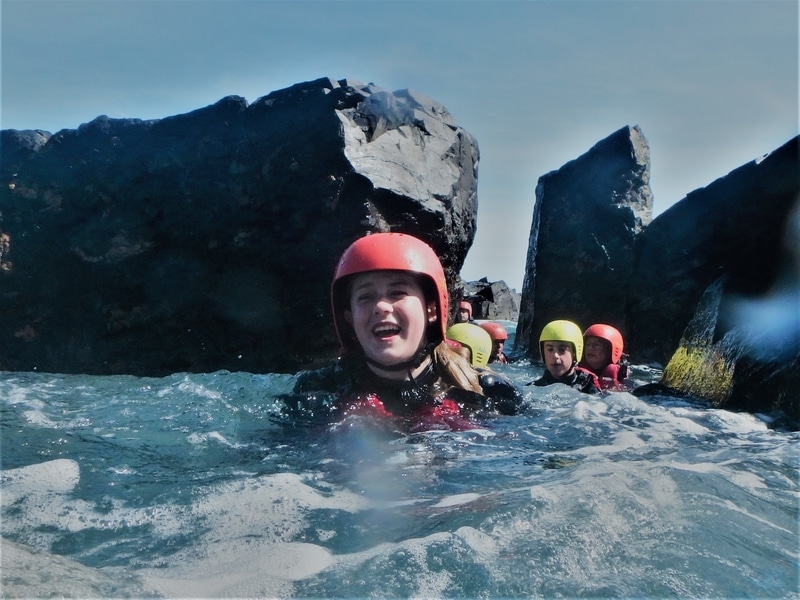
Jedi coasteering move: Lie half on your back, half on your side, facing the wall. As you reach your lower arm forwards to pull along the rocks, your legs will be behind you, counter-balancing your arms. This weight distribution is optimal for driving you forward, and with almost no effort you will simply ‘tip’ forwards with just a gentle bit of assistance from your arms. Try to hide that look of smugness as your comrades are slogging away swimming in open water just a few metres away.
Coasteering tip: When safe to do so, get in close to the rocks to make the most of reduced water flow and any opportunities for resting and/or pulling yourself along that the rocks may offer. Remember that...
Waves Don't Break In Deep Water
"Pace yourself, there’s no need to swim fast. What’s more important is swimming at a pace you can maintain and saving energy to make it through the session."
The concept of getting close to the rocks is counter-intuitive, as people seem to immediately associate being near the rocks as dangerous, so immediately head into more open water and immediately start finding swimming harder work. The important point is knowing when to get near the rocks and when to stay away. One of the most important things to know about coasteering is that Waves Do Not Break in Deep Water. It’s only as waves reach a shallow bottom that they will rear up and peel over. If your rock face, gully, etc., is in deep enough water, the waves will not break. Sure, the water may rise and fall, but get in close and enjoy being close to the rock. If in doubt, ask your coasteering guide, or copy what they are doing.
Pace yourself, there’s no need to swim fast. What’s more important is swimming at a pace you can maintain and saving energy to make it through the session. Swimming in the sea, especially against a current, it can often feel like you are getting nowhere. Choose a landmark in the middle distance to use as a reference point to see if you are actually moving. More often than not you are, so just keep plugging away. If it turns out you simply are not making progress, you may have no choice but to change course. If you are stuck in a current, unable to progress, simply swim perpendicular to the flow of the current and you will eventually exit the current (this is also how to exit a rip current on a beach, so that little tidbit of knowledge could save your life one day). If you can do this whilst aiming towards a friendly rock face so you can pull yourself along, or take a rest, go for it.
Coasteering tip: Swim at your own pace. Swim perpendicular to any currents if you are not making any progress.
Next comes the single biggest cause of problems for people coasteering…
Coasteering’s biggest challenge - Getting Out of the Water
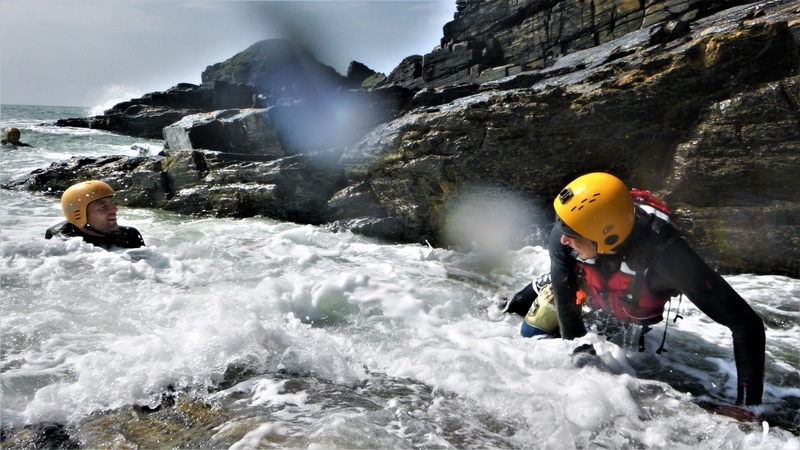
Failure to get out of the water quickly and efficiently is a real energy sapper and, it has to be said, most people who are new to coasteering are not naturally very good at this part. The approach you take will vary due to the angle of the rock, but the key is almost always in the use of the feet. Just because you saw Sylvester Stallone climb with only his hands in Cliffhanger doesn’t mean that the rest of us can. Your legs are much stronger than your arms, and as you ultimately want to end up standing up on the rocks, it’s best to get those legs to work as soon as possible.
If the rock you’re trying to exit onto is a flat, or low-angled platform or slab, try this: Swim at the rock and keep swimming. Despite what I said above, the mistake people make on low-angled exits is getting the legs involved too early (you can’t win, right?!). Swim as high as you can, and let a wave take you as high as possible, keeping the legs and body straight to avoid banging your knees. If the swell is up, actually body surf a wave in. When you’ve reached the highest point you need to quickly pop up, getting your legs underneath where your body is so you can quickly stand up in balance. If you’ve ever tried surfing, then this move can be likened to having to quickly pop up on a surfboard. Doing this manoeuvre at the highest possible point that swimming or body-surfing will allow means that you are already out of the water, and will have to deal less with wading or with waves trying to knock you over. Now you’re out, grab that popcorn and watch as the rest of the group flounder, tripping over themselves, slipping on seaweed and generally making heavy work of the simple move you just crushed a moment ago.
Coasteering tip: Use your legs as much as possible when trying to exit from the water.
Steeper Rock Exits
When the rock steepens up, it’s time to think like a rock climber. Yes, you’re going to have to use your hands, but equally, if not more important, are the legs. Approach the rock and find some good handholds you can use. You need to also fish around in the water for some edges, ledges or cracks to stand on. Without getting the feet on, exiting from the water is going to be nigh on impossible, so find those feet and get as much weight on them as you can. Now you’re on, it’s just a case of alternating moving to new hand and footholds as you move up the rock. Look at your hands and feet as you move them, and don’t look away until they’re securely on the next hold. Note that seaweed tends to make for poor handholds, as more often than not they will break when you need them most i.e. when all of your weight is hanging from them.
Let The Wave Do The Work
Whether the wave movement is slight, or whether it’s Armageddon out there, always try and work with the waves. As well as focusing on the rock in front of you, look at the sea around you, especially waves coming from behind you. Try to read the waves and anticipate what they’re doing. It will take a bit of practice, but if you get it right, you can let the waves lift you up and immediately put you on a high ledge, or a good set of high footholds. Be quick! When you get your chance, make sure you move your feet and get your body into position, ideally timing it so you arrive at your chosen ledge, with your feet in place exactly as the wave reaches its highest point. This is advanced stuff, so you may not become a coasteering Jedi during your first session.
Coasteering tip: Use wave action as much as possible to assist your exit.
Avoid the Cheese-Grater
What is the cheese-grater? Hopefully, you won’t find out. Even the coasteering experts don’t always get it right the first time. If you’re halfway through an attempt to exit the water and it doesn’t work out, rather than clutching desperately at the rock and getting cheese-grated back down the sharp rock surface, jump back into the water, well-clear of the rock. Re-establish your bearings, catch your breath if necessary and then try again. Not getting it right the first time is perfectly normal and is all part of the fun! Do make sure there is no one behind you before you jump, unannounced, back into the water.
Coasteering tip: Be prepared to jump back into the water, well-clear of the rocks if you don’t get your exit right the first time.
Cracks and Corners
"So there are no holds in the rock and/or it’s covered in slippery seaweed? Cracks and corners in the rock are your answer. Cracks provide something you can jam your toes into."
So there are no holds in the rock and/or it’s covered in slippery seaweed? Anyone who has been coasteering with us at low tide at Peninnis Head on the Isles of Scilly will know exactly what I’m talking about! Cracks and corners in the rock are your answer. Cracks provide something you can jam your toes into. Simply twist your foot so your toes are vertical. Slot the end of your shoes into the crack and turn your foot back down into its natural position. Hey Presto! Hopefully, your foot is now securely jammed in the crack, until you decide to twist it again to remove it and move it higher. It’s also possible to jam your hands in a crack, but without wearing a shoe on your hands, you may find the barnacles may exact a heavy toll for using this method. Still, it does work, just use with caution!
If one surface isn’t offering you an easy way out, then try two! A corner will give you two surfaces to push and pull off, and you may well be able to jam your toes in the back of the corner, just like you would with a crack. If you’re very lucky, the comer itself will be a crack too. Nature spoils us sometimes.
Coasteering tip: Use features in the rock, such as cracks, to jam hands and feet in for ‘bomber’ hand and footholds.
Choose Your Battles
One of the easiest ways to ensure a smooth exit from the boiling Atlantic is choosing the best place to attempt your exit in the first place. This often means the first section of rock you reach will not be the easiest place to climb. However, tired from swimming inefficiently, this is exactly where many people try and make their escape. Look around, where is being bashed by waves, where is calmer? Where does it look like there are good holds or ledges to climb up? A classic mistake is played out every day in the summer when we are coasteering at Praa Sands in west Cornwall. Due to the natural planes of weakness in the rock, the route is chock-full of sloping ledges. The route we take, more often than not means we arrive at the end of a ledge where it is still quite high out of the water. The walls are very steep and lack any good holds. Swimming an extra few metres means we can arrive at a point where the ledge is now dipping below the water. One doesn’t even need to climb, you just swim over the slab and stand up. Yet, people keep going for the first bit of rock they get to, thrashing themselves in a vain attempt to climb it, and using way more energy than the few extra strokes of swimming required to get them to the easiest possible exit.
Coasteering tip: Choose your exit wisely – it is unlikely to be the first piece of rock you reach.
Coasteering on Dry Land
Great, we’ve all successfully exited the water and our route now continues on the rocks. This can be a mixture of flat or low-angled slabs, boulders or steeper sections where we may almost enter into short steps of scrambling. We won’t deal with vegetated ground at this point, as that would indicate the coasteering session is over and we’re going up the exit, and we still want to do more coasteering right? We haven’t even done any jumps yet!
Flat Land
Definitely the easiest choice, and closest to how we move around for much of our daily lives. However, we’re not on a path and there will be numerous hazards, so keep looking at where you’re putting your feet and choosing your footholds accordingly. It’s not unusual to be traversing slippery, wave-washed ground. Remember that cracks are your friend. By carefully jamming your toes, or even your entire foot, in a crack, you have found a secure placement from which a slip is not possible. Small corners are gold, as well. Wedge your foot into one of these and it isn’t coming out until you say so. Even the smoothest rock surfaces will have little dimples and overlaps that form small edges. Use these tiny footholds and you’ll be surprised at how much security they can give. Study the rock well and choose every footstep carefully to prevent any spills onto the rock. If this isn’t working, choose another route (why are you ten metres into a carpet of luminous green algae before you have this thought?), or revert to that advanced coasteering technique – sliding along on your bum. Your guide will be very glad he insisted you wear some shorts over their wetsuit at this point.
Coasteering tip: Choose every footstep with care, always look for some feature in the rock, no matter how small, for a foothold.
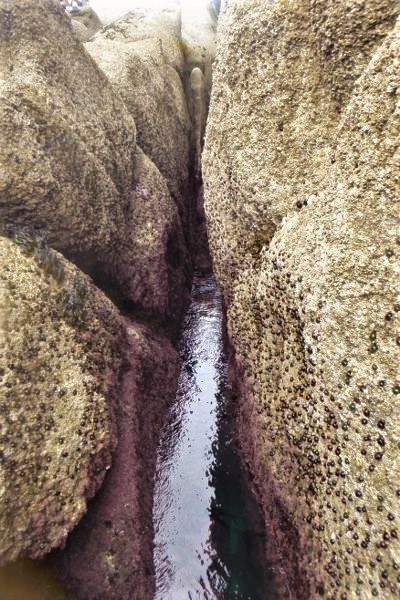
barnacles are your friend
Billions of these little crustaceans adorn the rocks around our coastline. They exclusively inhabit the intertidal zone, that area between high and low tide where we go for our coasteering adventures. Barnacles can be your worst enemy and they can be your best friend. Their hard shells are extremely sharp, and mishandling them can rip your hands apart. This is especially true if you are flailing and desperately trying to climb the rocks or swimming enthusiastically over shallow, barnacle-covered rocks. Despite this, they are a miracle in terms of the grip they provide for us to walk on. If you do find a section of rock devoid of barnacles on your route, you will notice how slippery it inevitably is, often like ice. Imagine if the whole route was like that? Barnacles give us sand-paper like grip in an environment where almost everything else is completely slippery. If you see barnacles in front of you, you know you can walk with confidence and their Velcro-like grip will even allow you to walk along high-angle surfaces, such as inclined faces of boulders.
Coasteering tip: Always walk on barnacles where possible.
Boulder Fields
This is some of the most awkward terrain we will encounter when coasteering, and also some of the most potentially hazardous. Hopefully, the route you’re coasteering on only has limited amounts of boulders, or if you’re lucky, none at all. Traversing boulders, you have no option but to take your time and be careful. Watch out, as there’s a chance that the rocks will be covered in some kind of algae or seaweed, which might not always be immediately obvious. Also, beware of wobbly rocks. Even the largest boulders may move unexpectedly. As you move, pay attention to your balance so if any slip or wobble occurs, you can immediately react. Where you see barnacles on the rocks, use these for grip, and move with confidence.
Rather than aiming for the tops of boulders, which may be slippery, or the gaps between the rocks, which will take forever to pick your way through; use constrictions where two rocks come together. Akin to putting your foot in a crack, using these constrictions will form a bomb-proof foot placement, even in slippery, seaweed-covered ground.
Coasteering tip: Constrictions between rocks and barnacles are solid foot placements, so use them as much as possible.
Steep Ground
Guided coasteering sessions will spend as little time on steep ground, where there is any risk of a fall, as possible. However, some short steps and walls may be unavoidable. As ever, climb carefully, looking at your hands and feet to ensure you are choosing the best holds available. Your guides will give you advice, as needed, and will also be spotting you, should a slip occur.
The notable exception to avoiding steep ground is if the landing is over deep water. Traversing rock walls, whilst remaining near sea level, or short challenges of super-steep water bouldering can be great fun, but they are rarely obligatory. Go and get stuck in, if you like the challenge of moving over steep rock, or casually swim on past if it’s not your cup of tea. Even over the deepest of water, we recommend not straying far above the water level, as an unexpected fall from height could result in a nasty landing if you get too high up. When traversing, it’s easy to get sucked into continuing to gain height. Your guide will keep you on the right path.
Coasteering tip: Always look at your feet when moving on steeper ground. Make sure your foot is secure before moving the next hand or foot.
"Traversing rock walls, whilst remaining near sea level, or short challenges of super-steep water bouldering can be great fun...Go and get stuck in, if you like the challenge of moving over steep rock..."
Extreme Wading
All of the above may take place in shallow water. Think submerged boulder fields and wave-washed slabs. Wading complicates things. Assume everything will be slippery, waves may seriously complicate matters, and it’s likely you can’t see where you’re putting your feet. As soon as the water is adequately deep, I recommend you start swimming. No more hesitantly tip-toeing your way along frictionless surfaces, or trying to pick your way through boulder fields, unable to see the gaps in the rocks. Wearing your equipment, you’re so buoyant, you need barely any water to slide your way along. Keep your legs straight to avoid banging your knees, and either swim with your arms or claw your way along by grabbing rocks. Mind those barnacles! As ever, try and use any wave motion to your advantage. Think like a seal!
If it makes sense to remain wading, it may be necessary to probe the ground ahead with a foot, before weighting it, to find a good foot placement. If you are wading through waves, turn so that you are perpendicular to the waves, and bend the knees to create a nice strong stance. This achieves two things. You are presenting a smaller surface area to the waves and you are in a powerful stance to resist being tipped over by any waves. Keep your eyes out to sea, to see waves as they approach – don’t face your back to them.
Coasteering tip: Save time, energy and a possible sprained ankle by swimming whenever possible.
Jumping in Coasteering
Ok, this is what you’ve been waiting for – you’re stood on a ledge ready to jump into the water. Your coasteering guide will have given you a jumping briefing, to ensure you have the fundamentals down before you take your first plunge. As per the rest of the guide, we’ll go into a little bit more detail here to make sure you’re getting top marks on those jumps. Practice makes perfect, start small and adjust your technique as necessary. If you’re not landing quite right, try any adjustments on smaller jumps to make any corrections. Don’t assume that they’ll miraculously sort themselves out if you go straight to the route’s top jump. Jumping is always optional and no one will judge you if you decide a certain jump is not for you.
Whether jumping comes naturally to you, or whether you are terrified, one rule trumps them all: be confident. A decided, confident approach is best. This will ensure a strong take-off, a good body position and, ultimately a good landing. Let’s look at the individual components that make up a jump.
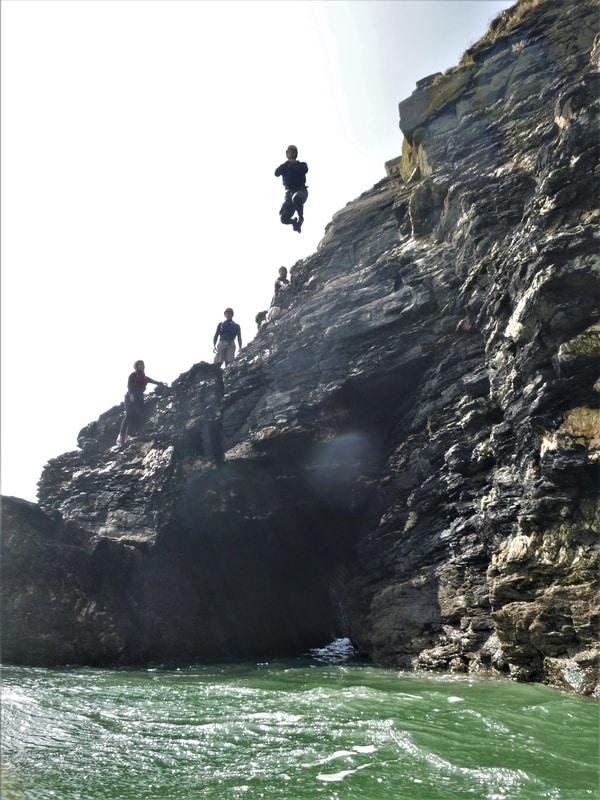
Lift Off
The manner in which you take off will largely determine what happens for the rest of your jump, so it’s important to get it right. The key is to start in balance. If you start in balance, you should finish in balance. Conversely, if you start your jump out of balance, you’re going to struggle to regain it before you reach the water. The first step is to choose your take-off spot. You’re looking for a flat section of rock, large enough for you to stand in balance, and with a clear line of sight of your landing area. You should only jump where your coasteering guide has indicated that it is safe to do so. Stand tall, and simply step out. There’s no actual need to ‘jump’, just step off. Your step is as simple as stepping off a pavement to clear a drain, for example. The height of the jump allows your trajectory to take you well clear of the rock and hit your landing spot.
Some people prefer to stand with both feet together, bend the knees, and then spring off. I prefer one foot forward and simply taking a step. As your back leg lifts up, your front leg will naturally recoil, like a spring. As your centre of gravity moves over your front leg, your leg will spring you forward, and will minimal effort you can jump surprisingly far. To aid with balance, we recommend you have your arms relaxed and out to your sides. Naturally swinging your arms back in preparation and then swinging them forward as you jump will enhance your clearance. Having your arms out will help maintain your balance for the next phase of the jump…
Coasteering tip: Take off in balance; land in balance.
The Flight Fantastic
“Falling isn’t so bad you know. It’s only the landing that hurts."
To quote Terry Pratchett, “Falling isn’t so bad you know. It’s only the landing that hurts.” Nevertheless, what you do whilst falling through the air will determine how you land. Assuming you’ve followed the steps described above, you’ve taken to the air and are well balanced and in control. All you have to do is maintain your body position and prepare for landing. With your arms out to your sides, they will ‘flap’ as required to make subtle adjustments to your balance and keep you upright. The good news is that this is an automatic reflex and it happens all by itself!
Now you have to prepare for landing. You’re going to want to land with straight legs and feet together, making your body as close to the shape of a dart as possible. If you have any urge to bend your legs as a reflex to absorb the impact, resist this at all costs. For extra brownie points, point your toes. You’re unlikely to be being judged for your form but, especially as the jumps increase in height, landing with flat feet can be uncomfortable.
With your body nice and straight, you also need to pay attention to your arms. If your arms remain out at your sides, at the very least you’re going to have some stinging hands. However, landing with unprotected arms does pose the risk of injury. Just before touch-down, cross your arms over your chest and hold on to your buoyancy aid. Make sure you hold this form, with protected arms and straight legs, until you have entered the water. Congratulations – you have just jumped off a cliff!
Coasteering tip: When landing, ensure a straight body position and remember to protect your arms.
You’re now back to the swimming part, so rinse and repeat as you enjoy your coasteering adventure. A final word will be given regarding the sea state, as this can turn everything on its head.
Coasteering on Rough Days
Wave action, known as ‘swell’ adds an entirely different dimension to the coasteering experience. Coasteering in the coastal environment, it is rare that the sea is ever flat. The limits we can safely coasteer in are quite narrow. Swells of 5 feet are usually the absolute maximum we can safely go coasteering in. Compare this with UK winter storms where we can see swells of at least twenty feet. In extreme storms, swells of forty feet may even sometimes reach our shores. Swells of 5 feet will barely get the surfers excited, but in our coasteering environment, that will give us extremely challenging conditions. The sea conditions change constantly, but its luck of the draw how conditions are going to be when you arrive for your adventure.
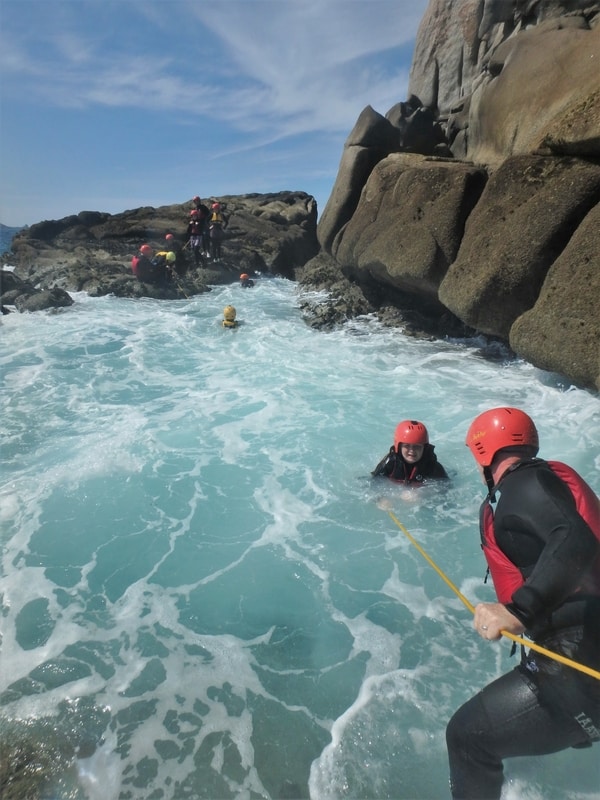
If you’re in luck, you’re coasteering on a day when the waves are up and there’s a bit of a swell running. Those of you who thought coasteering was just about cliff-jumping into bathtub-calm waters are about to get a bit of a shock! We love coasteering in a good swell. It’s exhilarating and the feeling of interacting with the power of the ocean is an incredible experience. It does go without saying that everything is harder work in larger swells. Swimming can become arduous. As the water swirls around and waves rise and fall and break against the rocks, progress can be seriously slowed. So it’s more important than ever to apply the tips we’ve discussed in this article. Move efficiently, and make the most of staying near rock faces that offer shelter and chances to rest. Hold onto rock faces when you can to save energy and to counter the effects of currents or waves you are moving against.
Exiting the water can become a serious challenge. Pick your spot well, work with the waves and move quickly. Remember that, ideally, you’re going to use a wave to get as high as possible. Caves, gullies, sluices and all the individual features of the route will come to life. They may come into optimum condition for exploration and fun, or they may become no-go areas. Your guide will lead you, so trust their detailed route knowledge.
Remember that all-important tip: waves do not break in deep water. This means if you are faced with incoming waves, the safest place to be is actually behind them, further out to sea. This may mean you have to go against your instincts which are telling you to retreat in the direction of dry land. Unless you are pretty much already out of the water, this is not the best course of action. You will simply be putting yourself in the impact zone, where the waves are breaking against the rocks. Instead, steel yourself and charge towards the waves. Duck under them, or jump over their crests. Either way, you’re aiming for the safe area – behind where the waves are breaking. You’re also getting further away from the impact zone on the inside.
Coasteering tip: Remember that the safe place is behind incoming waves, in deep water where waves don’t break.
Waves Come in Sets
If you have done any surfing, you will already know that waves don’t come in continuously. As they travel thousands of miles across the open ocean, they bunch themselves into groups, known as ‘sets’. Every swell is different, and therefore the numbers of waves in a set, and the gaps between sets can all very. A large gap between sets may lull you into a false sense of security, making you think it is calmer than it really is. Always keep in mind, that when you’re suddenly pinned in a narrow zawn getting a battering from wave after wave, you will, sooner or later, get a break, allowing you to quickly get to safety.
Coasteering tip: Always keep your eyes on the sea when coasteering, so you can see what waves are on the way and react accordingly.
Wow, that’s a lot of information. Here’s a quick summary of all the points we’ve been over:
Swimming
· Swim in an efficient, streamlined position with a straight body and legs flat on the surface.
· When safe to do so, get in close to the rocks to make the most of reduced water flow and any opportunities for resting and/or pulling yourself along that the rocks may offer.
· Swim at your own pace. Swim perpendicular to any escape any currents if necessary.
Exiting the Water
· Use your legs as much as possible when trying to exit from the water.
· Use wave action as much as possible to assist your exit.
· Be prepared to jump back into the water, well clear of the rocks, if you don’t get your exit right the first time.
· Use features in the rock, such as cracks, to jam hands and feet in for ‘bomber’ hand and footholds.
· Choose your exit wisely – it is unlikely to be the first piece of rock you reach.
Moving on Land
· Choose every footstep with care, always look for some feature in the rock, no matter how small, to use as a foothold.
· Always walk on barnacles where possible.
· In boulder fields, constrictions between rocks are solid foot placements, so use them as much as possible.
· Always look at your feet when moving on steeper ground. Make sure your foot is secure before moving the next hand or foot.
Wading
· Save time, energy and a possible sprained ankle by swimming whenever possible.
Cliff Jumping
· Take off in balance; land in balance.
· When landing, ensure a straight body position and remember to protect your arms.
And When it’s Rough
· Remember that the safe place is behind incoming waves; in deep water where waves don’t break.
· Always keep your eyes on the sea when coasteering, so you can see what waves are on the way and react accordingly.
We hope you have found this guide to getting the most out of your coasteering session useful. That’s a lot of information to try and apply if you’ve never been coasteering before. But practising these skills will be lots of fun and we hope it whets your appetite for many successful coasteering adventures. Get in touch with Kernow Coasteering now to book your coasteering adventure!








